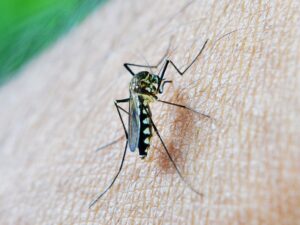Chikungunya: New Strategies Are Needed to Reduce Transmission
Abstract:
Florida, with its tropical and subtropical climate, provides an ideal environment for mosquitoes to thrive. While mosquitoes are often associated with more common diseases like West Nile virus and dengue, they also serve as vectors for rarer diseases such as chikungunya. This paper delves into the role of mosquitoes in Florida as transmission vectors for chikungunya, emphasizing the potential health implications and the need for new and more effective control measures.
Introduction
Chikungunya, a viral disease transmitted to humans by infected mosquitoes, has been identified in over 60 countries in Asia, Africa, Europe, and the Americas. While the disease is often associated with regions in Africa and Asia, there has been a growing concern about its spread to other parts of the world, including Florida.
1. Chikungunya: Transmission Dynamics
The primary vectors for chikungunya are Aedes aegypti and Aedes albopictus mosquitoes. These mosquitoes are prevalent in Florida and have been implicated in the transmission of other diseases like dengue and Zika. The presence of these vectors, combined with the state’s climate and the movement of infected individuals, makes Florida susceptible to chikungunya outbreaks.
Aedes aegypti:
- Habitat: Predominantly found in tropical and subtropical regions around the world.
- Behavior: Aedes aegypti mosquitoes are primarily daytime feeders, with peak activity during early morning and late afternoon.
- Breeding: They breed in man-made containers that hold water, such as buckets, bowls, animal dishes, flower pots, and vases.
- Disease Transmission: Aedes aegypti is a primary vector for transmitting chikungunya, as well as dengue, yellow fever, and Zika virus. They transmit these viruses through their bite when they feed on the blood of an infected person and then bite a healthy individual.
Aedes albopictus:
- Habitat: Also known as the Asian tiger mosquito, this species is native to Southeast Asia but has spread to many countries in the world, including parts of the United States and Europe.
- Behavior: Aedes albopictus is an aggressive daytime feeder but can also bite at dusk and dawn.
- Breeding: Similar to Aedes aegypti, they breed in small collections of water. However, they are more versatile and can breed in natural habitats like tree holes in addition to artificial containers.
- Disease Transmission: Aedes albopictus is a secondary vector for chikungunya. It also transmits dengue and Zika virus. Its role in spreading these diseases has increased as the mosquito has expanded into new territories.
2. Health Implications
Chikungunya is characterized by the following symptoms, and calls for the following pain management protocol in the absence of known medication:
- Onset of Symptoms:
-
- Fever: Sudden onset of high fever is often the first symptom.
- Joint Pain: Severe joint pain, often debilitating, is a hallmark of the disease. It typically affects multiple joints, with hands, wrists, ankles, and feet being common sites.
- Other Symptoms: These can include headache, muscle pain, joint swelling, and rash.
-
- Evolution of Symptoms:
-
- The acute phase, characterized by fever and joint pain, usually lasts for a few days to a couple of weeks.
- Most patients recover fully, but in some cases, joint pain may persist for months or even years. This chronic phase is more common in older adults.
- Symptoms such as fatigue and a general feeling of being unwell can also linger.
-
- Treatment and Control in Humans:
-
- There is no specific antiviral treatment for chikungunya. Management focuses on relieving symptoms.
- Fever and Pain Management: Over-the-counter medications like acetaminophen or ibuprofen can help reduce fever and alleviate pain.
- Hydration: Adequate fluid intake is crucial to prevent dehydration.
- Rest: Rest aids recovery.
-
As mentioned above, there is currently no vaccine or specific antiviral treatment for chikungunya, making prevention through vector control crucial.
3. Response by Public Authorities in Florida
Given the potential health implications, Florida public authorities have implemented various measures to monitor and control the spread of chikungunya. These include enhanced mosquito population monitoring, public education campaigns, and vector control initiatives. Despite these efforts, the state has witnessed several outbreaks, underscoring the need for continuous vigilance.
4. Chikungunya: Transmission Control Challenges
One of the primary challenges in controlling chikungunya in the state is the presence of insecticide-resistant mosquito populations. This resistance undermines traditional vector control methods and necessitates the exploration of alternative strategies.
Conclusion
Chikungunya, though less common than other mosquito-borne diseases, poses a significant public health risk in Florida due to the presence of its primary vectors and favorable environmental conditions. Effective vector control via research and the implementation of new strategies, combined with public awareness campaigns, is crucial to mitigate the spread of this disease.
References
“Transmission risk of two chikungunya lineages by invasive mosquito vectors from Florida and the Dominican Republic.” Alto, B.W., Wiggins, K., Eastmond, B., Velez, D., Lounibos, L.P., & Lord, C.C. (2017).
“Encephalitic alphaviruses.” Zacks, M.A. & Paessler, S. (2010).
“Emerging Infectious Diseases of Wildlife– Threats to Biodiversity and Human Health.” Daszak, P., Cunningham, A.A., & Hyatt, A.D. (2000).
“Insecticide Resistance Status of United States Populations of Aedes albopictus and Mechanisms Involved.” Marcombe, S., Farajollahi, A., Healy, S.P., Clark, G.G., & Fonseca, D.M. (2014).


